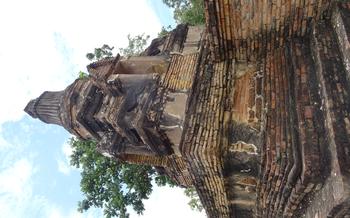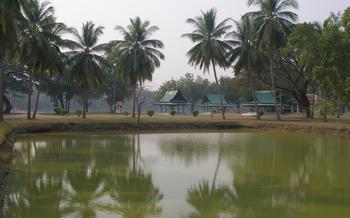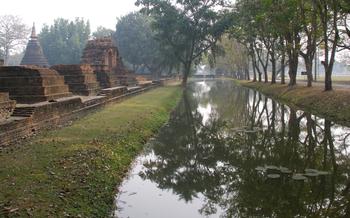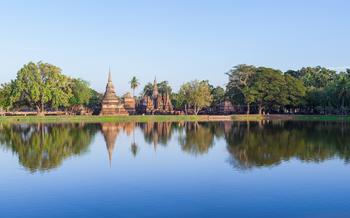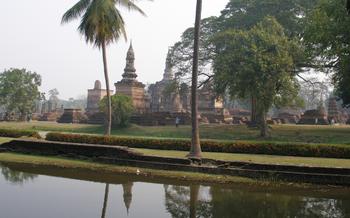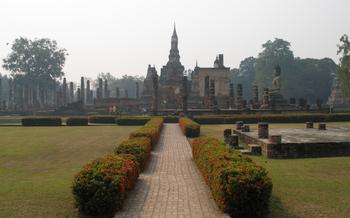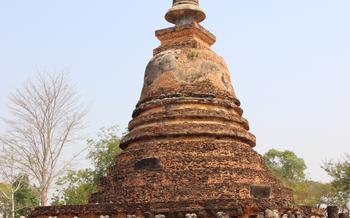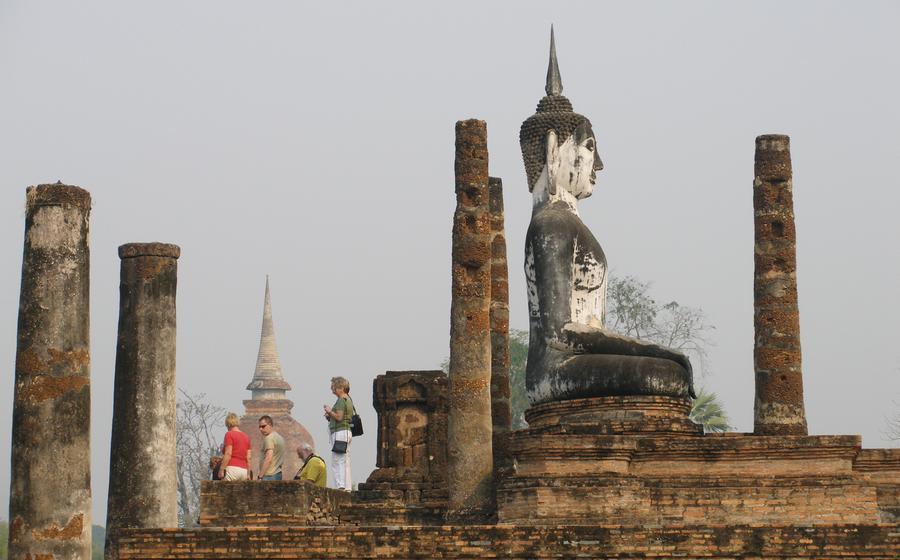
Wat Chedi Jet Thaew
- Location and Accessibility
- Exploring the Temple Grounds
- Historical Significance
- Unique Architectural Features
- Religious and Cultural Importance
- Symbolism and Legends
- Exploration Tips
- Photography Opportunities
- Nearby Attractions
- Accommodation Options
- Food and Dining
- Shopping and Souvenirs
- Guided Tours and Local Guides
- Benefits of Guided Tours
- Tips for Finding a Reputable Tour Operator
- Advance Booking and Cost-Effective Options
- Insider Tip: Unveiling the Secrets of Wat Chedi Jet Thaew
Location and Accessibility
Wat Chedi Jet Thaew is conveniently located within the Sukhothai Historical Park, a UNESCO World Heritage Site situated in the heart of Sukhothai province. The park encompasses an extensive collection of ancient temples, stupas, and ruins that provide a glimpse into the rich history of the Sukhothai Kingdom. To reach Sukhothai from major cities like Bangkok, various transportation options are available, including buses, trains, and flights.
From Bangkok, the most convenient option is to take a bus or train. Buses depart from the Northern Bus Terminal (Mo Chit) and take approximately 6-7 hours. Trains depart from Hua Lamphong Railway Station and take slightly longer, around 7-8 hours. Both options offer comfortable seating and scenic views along the way.
For those traveling by air, Sukhothai Airport (THS) is located just 30 kilometers from the city center. Several low-cost airlines operate flights from Bangkok and other major cities in Thailand. From the airport, you can take a taxi or tuk-tuk to reach the Sukhothai Historical Park.
Once inside the park, finding Wat Chedi Jet Thaew is relatively easy. It is located in the central part of the park, just a short walk from the main entrance. Look for the tall, distinctive chedi that rises above the surrounding trees.
Exploring the Temple Grounds
The temple complex of Wat Chedi Jet Thaew is a treasure trove of architectural wonders and sacred artifacts. The main stupa, a towering structure of brick and stucco, dominates the skyline. Its bell-shaped dome, intricate stucco decorations, and lotus-bud finial are testament to the artistry and devotion of the Sukhothai people. The viharns, or assembly halls, flank the stupa, their walls adorned with exquisite murals depicting scenes from the life of Buddha.
Within the viharns, you'll find a collection of Buddha images in various postures and mudras. Each image is a masterpiece of craftsmanship, showcasing the unique artistic style of the Sukhothai period. The ordination hall, where monks were ordained, is another notable structure within the complex. Its elegant design and well-preserved condition offer a glimpse into the religious ceremonies and rituals that took place here centuries ago.
As you explore the temple grounds, keep an eye out for other interesting features, such as the stone inscriptions, stupas, and statues that dot the landscape. These artifacts provide valuable insights into the history, culture, and beliefs of the Sukhothai Kingdom. Remember to be respectful and mindful of the religious significance of the site, and observe proper etiquette while visiting the temple.
Historical Significance
Wat Chedi Jet Thaew played a pivotal role in the Sukhothai Kingdom, serving as a significant religious and cultural center. It was a royal temple, patronized by the Sukhothai kings, who held ceremonies and rituals within its sacred grounds. The temple's construction marked a turning point in Thai architecture, showcasing innovative design elements and intricate stucco decorations that would become characteristic of the Sukhothai style.
Throughout history, Wat Chedi Jet Thaew has witnessed numerous events and stories that have shaped its significance. It survived several wars and invasions, including the fall of the Sukhothai Kingdom in the 15th century. Despite the passage of time and the ravages of war, the temple's remarkable resilience stands as a testament to its enduring importance.
In recognition of its exceptional cultural and historical value, Wat Chedi Jet Thaew was designated as a UNESCO World Heritage Site in 199This prestigious designation acknowledges the temple's outstanding universal value and its contribution to the world's cultural heritage. Today, it stands as a symbol of Thailand's rich history and a source of pride for the Thai people.
Unique Architectural Features
Wat Chedi Jet Thaew stands out for its distinctive architectural features that showcase the ingenuity and artistry of the Sukhothai era. The main stupa, known as the "bell-shaped chedi," is a prime example. Its graceful shape resembles an inverted bell, with a circular base that tapers upwards to a pointed finial. This design symbolizes the Buddha's journey towards enlightenment, rising from the mundane to the spiritual realm.
The surface of the chedi is adorned with intricate stucco decorations, a hallmark of Sukhothai architecture. These delicate adornments depict various motifs, including mythical creatures, celestial beings, and floral patterns. Each design holds symbolic meaning, representing the Buddhist cosmology and teachings. The stucco work adds a layer of intricacy and elegance to the chedi, transforming it into a masterpiece of artistic expression.
The chedi's architectural style reflects influences from other cultures and regions, highlighting the interconnectedness of the ancient world. Some scholars believe that the bell-shaped stupa was inspired by Sri Lankan architecture, while others suggest that it shows similarities to Khmer and Burmese designs. This blending of influences resulted in a unique and harmonious architectural style that is distinctively Sukhothai.
Over time, Sukhothai architecture evolved, incorporating new elements and refining existing ones. Wat Chedi Jet Thaew exemplifies this evolution, showcasing the transition from the earlier, more austere style to the later, more elaborate and ornate style that characterizes the Sukhothai period. The temple complex serves as a testament to the architectural prowess of the Sukhothai Kingdom, showcasing its unique blend of local traditions and external influences.
Religious and Cultural Importance
Wat Chedi Jet Thaew holds immense religious and cultural significance in Thai Buddhism and the local community. As an active Buddhist temple, it serves as a place of worship, meditation, and spiritual refuge for devotees. Throughout the year, various ceremonies and rituals are performed, including merit-making, chanting, and offerings to the Buddha. The temple also plays a crucial role in local traditions and festivals, such as the annual Loi Krathong and Songkran celebrations. During these events, the temple becomes a vibrant hub of activity, with colorful decorations, traditional performances, and communal feasting. The temple's enduring importance as a spiritual and cultural center has contributed to the deep sense of identity and heritage among the people of Sukhothai.
Symbolism and Legends
Wat Chedi Jet Thaew is steeped in symbolism and legends that add to its mystique and significance. The chedi's distinctive shape, resembling a lotus flower, represents the purity and enlightenment of the Buddha's teachings. Each level of the chedi symbolizes a different stage of the Buddha's journey to enlightenment, culminating in the pinnacle, which represents the ultimate goal of nirvana.
Legends surround the temple's construction, attributing it to supernatural forces. One tale tells of a mysterious white elephant that carried a sacred relic on its back and led the people of Sukhothai to the site of the temple. Another legend speaks of a miraculous event where the chedi was built in a single night by an army of divine beings.
These stories and symbols are deeply embedded in the cultural and religious beliefs of the Thai people, making Wat Chedi Jet Thaew a place of profound spiritual significance. Visitors can explore the temple grounds, marvel at the architectural symbolism, and immerse themselves in the legends that have shaped its history and meaning.
Exploration Tips
To fully appreciate the beauty and significance of Wat Chedi Jet Thaew, it's recommended to visit during the early morning or late afternoon when the light is at its most flattering. Plan to spend at least an hour exploring the temple grounds, allowing ample time to admire the intricate details of the chedi, viharns, and other structures. Remember to dress respectfully, covering your shoulders and knees, as is customary when visiting temples in Thailand. While there are no specific facilities within the temple complex, there are restrooms and a souvenir shop located nearby.
Photography Opportunities
Wat Chedi Jet Thaew presents a treasure trove of photographic opportunities for enthusiasts of all levels. To capture the temple's grandeur, ascend to the elevated walkways that encircle the chedi. From here, you'll have unobstructed views of the intricate stucco decorations and the surrounding landscape. Utilize a wide-angle lens to encompass the entire structure and convey its majestic scale.
For close-up shots, focus on the exquisite details that adorn the chedi and viharns. The delicate stucco reliefs, depicting scenes from Buddhist mythology, demand your attention. Experiment with different angles and lighting conditions to highlight the depth and texture of these intricate carvings. A macro lens will enable you to capture the finer details and reveal the artistry that went into their creation.
The play of light and shadow within the temple grounds adds a dramatic element to your photographs. Visit during the golden hours of sunrise or sunset to capture the warm, diffused light that casts long shadows and accentuates the architectural features. Experiment with different shutter speeds to convey a sense of movement in the clouds or foliage.
When editing your temple photos, consider using post-processing techniques to enhance their impact. Adjust the contrast and saturation to make the colors more vibrant and bring out the intricate details. Experiment with black-and-white conversions to create a timeless and atmospheric look. By carefully considering composition, light, and post-processing, you'll transform your temple photos into stunning works of art that capture the essence of this sacred site.
Nearby Attractions
Enrich your Sukhothai experience by exploring beyond Wat Chedi Jet Thaew. Sukhothai Historical Park is a treasure trove of ancient temples, each with its own unique charm. Wander through the serene grounds of Wat Mahathat, marvel at the majestic ruins of Wat Sri Sawai, and discover the hidden beauty of Wat Traphang Thong.
For a glimpse into local life, venture into the bustling markets and souvenir shops of Sukhothai town. Here, you can find authentic handicrafts, textiles, and souvenirs to take back home as cherished keepsakes. Indulge in the vibrant flavors of Thai cuisine at local restaurants or savor the delights of street food for a budget-friendly feast.
If you have time, extend your journey to the nearby Si Satchanalai Historical Park, another UNESCO World Heritage Site. Located just 50 kilometers from Sukhothai, this park boasts an array of impressive temples and ancient ruins, including Wat Chang Lom, Wat Chedi Chet Thaew, and Wat Khao Phra Bat Noi.
Insider Tip: Rent a bicycle to explore the historical park at your own pace. It's a great way to soak in the tranquil atmosphere and discover hidden gems along the way.
Accommodation Options
Sukhothai offers a range of accommodation options to suit all budgets and preferences. Whether you're looking for a luxurious resort, a cozy guesthouse, or a budget-friendly hostel, you'll find something to meet your needs.
For those seeking a high-end experience, the Sukhothai Treasure Resort & Spa is a top choice. This five-star resort offers elegant rooms and suites, a stunning pool, and a world-class spa.
For a more affordable option, the Baan Thai Guesthouse is a popular choice among backpackers and budget travelers. This family-run guesthouse offers clean and comfortable rooms at a very reasonable price.
If you're looking for something in between, the Sukhothai Heritage Resort is a good option. This mid-range resort offers spacious rooms and a beautiful pool, all within walking distance of the historical park.
No matter what your budget or preferences, you're sure to find the perfect place to stay in Sukhothai.
When choosing a place to stay, it's a good idea to consider the location. If you're planning on visiting the temple frequently, it's best to stay somewhere within walking distance. The Old City is a good area to stay in, as it's home to many temples and historical sites.
It's also a good idea to book your accommodation in advance, especially if you're traveling during the high season (November to February). This will ensure that you get the best room rates and availability.
Food and Dining
Sukhothai offers a delectable array of local dishes and specialties that will tantalize your taste buds. For an authentic Thai culinary experience, head to the lively night market, where you can savor mouthwatering street food at budget-friendly prices. Sample the iconic boat noodles, a Sukhothai specialty that combines tender noodles in a rich and flavorful broth, or indulge in the crispy and tangy papaya salad, a refreshing and spicy treat.
For a more refined dining experience, visit one of the many restaurants in the city center. Here, you can savor traditional Thai dishes prepared with fresh, local ingredients. Don't miss the khao soi, a creamy and flavorful curry noodle soup that is a northern Thai specialty, or the massaman curry, a rich and fragrant curry that is sure to satisfy your cravings.
If you have dietary restrictions, fret not, as Sukhothai offers plenty of vegetarian and vegan options. Many restaurants cater to the needs of those with special dietary requirements, offering delicious and nutritious dishes that will leave you feeling satisfied.
Remember to embrace the local culture and customs when dining in Sukhothai. It is considered polite to remove your shoes before entering a restaurant, and to use a spoon and fork instead of chopsticks when eating noodles. Tipping is not customary in Thailand, but feel free to leave a small gratuity if you are particularly impressed with the service.
Indulge in the culinary delights of Sukhothai and discover the vibrant flavors and aromas that make this region a foodie's paradise. From the bustling night market to the charming restaurants, there is something to satisfy every palate in this culinary haven.
Shopping and Souvenirs
Sukhothai offers a treasure trove of shopping opportunities for those seeking unique souvenirs and local handicrafts. Within the Sukhothai Historical Park, you'll find several shops selling replicas of ancient artifacts, pottery, and textiles inspired by the Sukhothai era. For a wider selection of souvenirs, head to the local markets, such as the Thung Thalay Luang Market, where you can browse stalls selling everything from handmade clothing and accessories to local snacks and spices.
When shopping in Sukhothai, be sure to look out for items made from local materials, such as cotton, silk, and celadon pottery. These items are often handcrafted by local artisans, making them unique and meaningful souvenirs. Bargaining is common in the markets, so don't be afraid to haggle for a good price. However, always be respectful and remember that the prices are often already quite low.
If you're looking for something truly special, consider purchasing a piece of celadon pottery. Celadon is a type of green-glazed ceramic that was popular in Sukhothai during the 13th and 14th centuries. Today, celadon pottery is still produced in Sukhothai, and you can find beautiful pieces for sale in the local markets and shops.
Supporting local artisans and the local economy is an important part of responsible tourism. By purchasing souvenirs from local vendors, you're not only taking home a piece of Sukhothai with you, but you're also helping to support the livelihoods of the local community.
Guided Tours and Local Guides
Enrich your visit to Wat Chedi Jet Thaew by opting for a guided tour. Knowledgeable guides can provide valuable insights into the temple's history, architecture, and religious significance, bringing the ancient ruins to life. Tours are available in English and other languages, ensuring that visitors from all backgrounds can appreciate the wonders of this UNESCO World Heritage Site.
Benefits of Guided Tours
Guided tours offer several advantages. Firstly, they provide a structured and informative experience, ensuring that you don't miss any important details or highlights of the temple complex. Secondly, guides can answer your questions and provide additional information that may not be readily available online or in guidebooks. Thirdly, they can help you navigate the vast Sukhothai Historical Park, ensuring that you make the most of your time and see the most important temples and monuments.
Tips for Finding a Reputable Tour Operator
To ensure a high-quality and informative experience, it is crucial to choose a reputable tour operator. Look for companies that are licensed and have a good reputation among travelers. Read online reviews and recommendations from fellow travelers to get a sense of the quality of their services.
Advance Booking and Cost-Effective Options
To avoid disappointment, especially during peak tourist seasons, it is advisable to book your guided tour in advance. This will guarantee your spot and allow you to plan your itinerary accordingly. Guided tours typically range in price, depending on the duration, group size, and inclusions. For budget-conscious travelers, there are cost-effective options available, such as group tours or shared guides.
Insider Tip: Unveiling the Secrets of Wat Chedi Jet Thaew
As you explore the enchanting grounds of Wat Chedi Jet Thaew, keep an eye out for hidden corners and secluded spots that offer unique perspectives and experiences. One such gem is the ancient Bodhi tree, believed to be over 700 years old, which emanates a serene aura and invites contemplation. Embrace the tranquility of this sacred tree, soak in the spiritual energy, and find a moment of inner peace amidst the grandeur of the temple.
For a truly immersive experience, consider visiting during the annual Loi Krathong festival, when the temple comes alive with vibrant colors and floating lanterns. Witness the spectacle of thousands of krathongs, adorned with flowers, candles, and incense, illuminating the moat surrounding the temple. This magical festival is a feast for the senses and a wonderful opportunity to connect with the local culture and traditions.
As you delve deeper into the temple's history, uncover the intriguing legend associated with its construction. It is said that the temple was built in a single night by a mysterious group of spirits who were captivated by the beauty of the location. This captivating tale adds an air of enchantment to the temple, making it a truly unforgettable destination.
